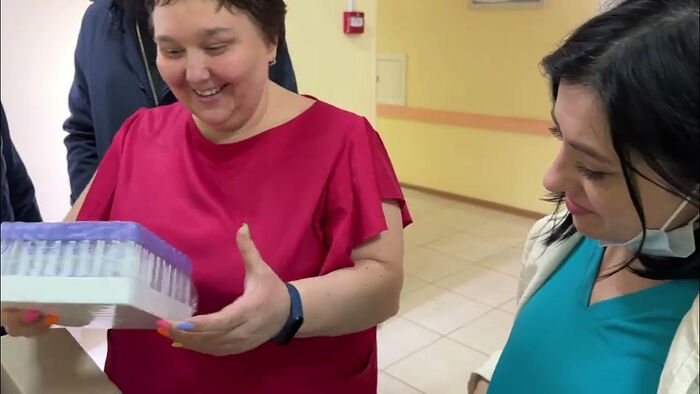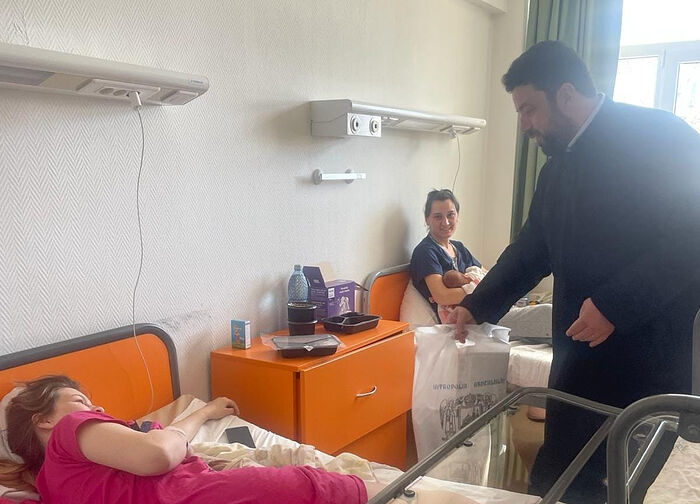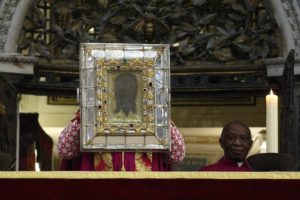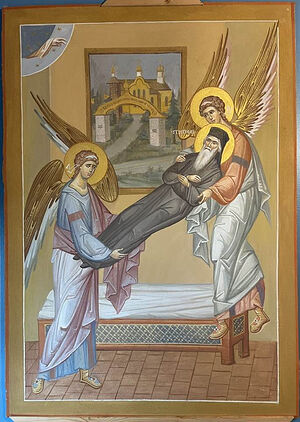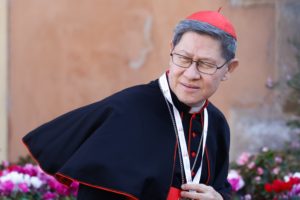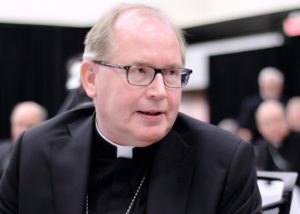Several hours after the Francis Scott Key Bridge collapsed into the Patapsco River March 26, more than 200 people, many of them still in a state of shock, gathered in prayer at a 5:30 p.m. Mass at the Cathedral of Mary Our Queen in Baltimore.
The bridge collapsed about 1:30 a.m. after a 900-foot container ship seemed to have problems with its power and collided into one of the bridge’s support pilings.
Six construction workers who had been working on the bridge at the time of its collapse are missing and presumed dead. Two other construction workers were rescued, one of them hospitalized. There were also several cars that plunged into the river.
In his homily at the somber liturgy, Archbishop William E. Lori encouraged prayers for those whose lives were lost, their survivors and all whose lives and livelihoods will be impacted by the collapse. He also encouraged the congregation to resolve to love those God has placed in their lives and to let them know how much they are loved.
“Our minds turn first and foremost to those whose lives were lost and the loved ones who are facing this unthinkable and unexpected news,” Archbishop Lori said. “While we know that our lives are fragile, a moment such as this reminds us what can change in but an instant. In the charity of our prayers tonight, we lift up these souls, those who have gone and those who remain, to the Lord of life and love.”
The archbishop noted that in the days and weeks ahead, many others will be affected by the tragedy.
“Seafarers from across the globe, people who already labor under very difficult conditions, are now stranded in the Port of Baltimore,” he said. “Many men and women throughout our region whose livelihoods depend on our port are filled with fear and uncertainty as they look at the road that lies ahead.”
The archbishop said communities across the region will be “impacted by the severing of this vital transportation link.” He emphasized that the days ahead will demand “ongoing concern, love and generosity” in support of those affected by the collapse.
“It is often the case that when tragedy strikes, we are shaken from our normal way of seeing things; our hearts are moved to think of those who are impacted and suffering,” he said. “But as time goes by and the normal demands of daily life impose themselves upon us, it is easy for us to forget this experience and to forget those whose lives will not go back to normal.”
Auxiliary Bishop Bruce A. Lewandowski, who concelebrated the Mass along with Auxiliary Bishop Adam J. Parker, told the Catholic Review, Baltimore’s archdiocesan news outlet, that Redemptorist Father Ako Walker was with the families of the six construction workers as they awaited news about their loved ones. The U.S. Coast Guard announced late in the day it had ended its search-and-rescue operation. Father Walker is the bilingual pastor of Sacred Heart of Jesus-Sagrado Corazón de Jesús in Baltimore’s Highlandtown neighborhood. The construction workers are all believed to be Hispanic.
“He’s there and offering prayer and presence,” Bishop Lewandowski said. “It’s a very sad situation. It’s good that he can be there and, through him, the church can offer comfort and reassurance to the families. I just can’t imagine what they must be going through.”
The bishop said the church has offered whatever support it can through the Esperanza Center, a Catholic Charities operation in East Baltimore that supports immigrant communities. In the event that families will need churches for funerals, Bishop Lewandowski said, that also will be made available.
The Catholic Church has been working with Giuliana Valencia-Banks, Baltimore County’s immigrant affairs outreach coordinator and a former employee of the Esperanza Center, to help coordinate support to families.
Bishop Lewandowski noted that Catholic leaders also have been in touch with people they know in the Hispanic community who do high-level bridge construction work to check on their safety since many of them are parishioners of Sacred Heart of Jesus.
“Some called back and some did not,” he said.
Andy Middleton, director of the Archdiocese of Baltimore’s Apostleship of the Sea ministry to seafarers at the Port of Baltimore, offered one of the readings at the cathedral Mass.
Middleton told the Catholic Review that Apostleship of the Sea had ministered to members of the crew of the cargo ship Dali March 24 and 25, delivering Easter boxes to the ship’s crew. He had been in touch with one of the crew members on the disabled cargo ship “four or five times” after the bridge collapse, he said.
“It’s a matter of staying in contact with them,” he said, noting that everyone on the ship was safe and uninjured. “They know that we are praying with them.”
Lora Hargrove, a parishioner of St. Bernardine in West Baltimore and the interfaith outreach director for Maryland Gov. Wes Moore, represented the governor at the cathedral liturgy.
Following the Mass, she told the Catholic Review it was important for her to be present “to represent all faiths together so that we can watch each other, watch over each other — pray with each other.”
Father Kevin Ewing, pastor of the Catholic Community of South Baltimore, told the Catholic Review earlier in the day that many of his parishioners, their family members and others are associated with the Port of Baltimore as ship workers or stevedores. The parish offered a 7 p.m. Mass March 26 at Our Lady of Good Counsel to pray for all those affected by the tragedy.
“We’ve heard from family members in that regard who just want to come together to pray,” he said. “It’s a chance for us to try and see how we can help them navigate however their lives or their livelihood is impacted.”
The Catholic Community of South Baltimore, made up of Our Lady of Good Counsel, St. Mary Star of the Sea and Holy Cross, has been in touch with Apostleship of the Sea to provide whatever material support or accompaniment that may be needed in the months to come, Father Ewing said.
According to a March 26 statement from the Port of Baltimore, vessel traffic into and out of the port has been suspended until further notice.
In an afternoon briefing at the White House, President Joe Biden pledged to use federal resources to rebuild the bridge. He noted that the Port of Baltimore is one of the nation’s largest shipping hubs, handling a record amount of cargo last year.
He said that 15,000 jobs “depend on that port. And we’re going to do everything we can to protect those jobs and help those workers.” The bridge is important to the entire Northeast Corridor, with more than 30,000 vehicles crossing it every day, he added.
The Francis Scott Key Bridge was constructed between 1972 and 1977 at a cost of $60.3 million. The four-lane bridge had covered 1.6 miles and had a traffic volume of 11.3 million vehicles annually.
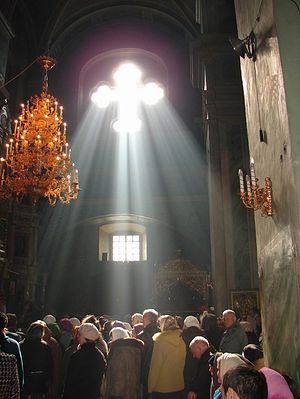
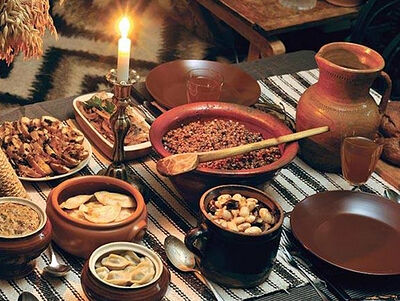 The Meaning and Significance of FastingFasting is a necessary means for success in the spiritual life and for attaining salvation; for fasting—depriving the flesh of excessive food and drink—weakens the force of sensual drives.
The Meaning and Significance of FastingFasting is a necessary means for success in the spiritual life and for attaining salvation; for fasting—depriving the flesh of excessive food and drink—weakens the force of sensual drives. Spring Cleaning of the SoulFasting is a type of service of God, where the main goal is not to kill the flesh, but to subdue the insatiable body to the soul, rising it up and bringing it closer to Christ.
Spring Cleaning of the SoulFasting is a type of service of God, where the main goal is not to kill the flesh, but to subdue the insatiable body to the soul, rising it up and bringing it closer to Christ. Let Us Enter the Fast With JoyThis pledge of love is expected and required, and even lovingly entreated of us by Christ—the Divine lover of our souls!
Let Us Enter the Fast With JoyThis pledge of love is expected and required, and even lovingly entreated of us by Christ—the Divine lover of our souls!